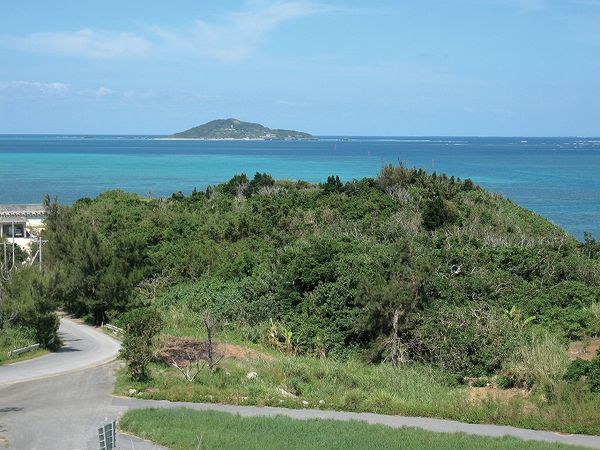トップ > 市の組織 > 教育委員会 > 生涯学習部 > 生涯学習振興課 > 【市指定史跡】 島尻元島とンナカガー
【市指定史跡】 島尻元島とンナカガー
〔しまじりむとぅずまとんなかがー〕
島尻元島は現在の島尻集落の発祥地であると伝えられている。この元島は旧10月~12月に5回、島立の先祖をまつる神事が催されることで知られている。この元島の住民がいつ頃、どこからやってきて、この地に住みついたのか定かでない。第二次世界大戦直後までは6、7世帯が住んでいたが、現在では全世帯が元島を離れてしまい、その屋敷跡だけが残されている。
元島は海岸に面した周囲に石垣が積まれており南南西に向いて出入口が一つある。この出入口には戦争直前まで石積みのアーチ門があった。元島内に井泉はなく、元島から南へ20mほど離れた畑の中に元島住民が使用したと推定される井戸(ンナカガー)がある。又、北崖下には貝塚がある。この元島からは宮古式土器・青磁器・南蛮焼等の破片が採取されることから、元島住民はこれらの焼物等を使用していたと思料される。
現在、宮古島にいつ頃から人々が住みついていたのか、研究者のあいだで色々な論議が交わされているが、この元島もそれを解明する上での1つの手がかりになるものと考えられる。
【Historic Site Designated by the City】 Shimajiri-Motojima and Nnakaga
It is said that the Shimajiri-Motojima was the origin of the present Shimajiri settlement. This Motojima is known for its five ceremonies held through October to December of the lunar calendar to celebrate the ancestors of the island. It is not clear where the ancestors of this Motojima came from or when they started to live here. Up until the end of the Second World War, there were six or seven households that lived here, but presently, they have all left the Motojima, and only empty houses remain.
There are piled stone walls surrounding the side where the Motojima faces towards the coast, and there is an entrance/exit facing the south-southwest. There was an arched gate with piled stones at the entrance/exit up until immediately after the war. There are no wells or springs within the Motojima, but about 20 m to the south, there is a Nnakaga well that is believed to have been used by the former residents of this Motojima. At the bottom of the cliffs to the north, there is a shell mound. From the findings of Miyako-style earthenware, celadon, Chinese pottery pieces and the like, it is believed that the residents of the Motojima used these ceramics.
Presently, there are numerous theories on when people began to live on Miyako Island, and this Motojima is believed to hold a clue to finding the answer to this debate.
【市指定史跡】 島尻元島和水井
島尻元島據說,是現在島尻村落的發祥地。這個元島在舊曆10月~12月之間,會舉行五次祭祀島立先祖的祭神儀式而聞名於世。島上居民從何時何處,來到這個島上定居並不清楚。直到第二次世界大戰後不久,還有6、7戶人家住在那裡,現在所有的居民都已離開元島,只剩下空盪盪的房屋遺跡。
元島面向海岸周圍是石砌的圍牆,西南偏南方向有個出入口。這個出入口在戰爭爆發之前,有個石砌的拱門。元島內沒有井泉,從元島往南距離20公尺左右的田地中,有一個據推測是元島居民曾經使用過的水井。此外,北側山崖下有貝塚。從這個元島出土了宮古式陶器、青瓷器、南蠻陶器等碎片,可見元島居民曾經使用這些陶瓷器。
現在,關於從何時有人開始居住在宮古島這一問題,研究者之間進行了各種各樣的討論,元島似乎是解開這個謎底的線索之一。
【미야코지마시 지정 사적】 시마지리 모토지마와 은나카가
시마지리 모토지마는 현재의 시마지리 마을 발상지로 전해져 있다. 모토지마는 음력 10-12월 사이에 섬의 선조를 모시는 제사를 다섯 번 행하는 것으로 알려져 있다. 모토지마의 주민들이 언제쯤부터, 어디서 와서 이 곳에 살게 되었는지는 분명하지 않다. 제2차 대전 직후까지는 6, 7 세대가 살고 있었으나 현재는 모두 모토지마를 떠나, 그 집들의 흔적만이 남아 있다.
모토지마는 해안에 접한 주위에 돌담이 쌓여 있고, 남남서쪽 향해 출입구가 한 군데 있다. 이 출입구에는 전쟁 직전까지 돌을 쌓아 올린 아치 문이 있었다. 모토지마 내에는 우물이 없으며, 모토지마에서 남쪽으로 20m 정도 떨어진 밭 안에 모토지마 주민들이 사용했던 것으로 짐작되는 우물(은나카가)이 있다. 또한 북쪽 절벽 아래에는 패총이 있다. 모토지마에서 미야코식 토기, 청자, 남만 도자기 등의 조각이 채취되었던 것으로 미루어 모토지마 주민들이 도자기 등을 사용했던 것을 알 수 있다.
현재, 미야코섬에 언제부터 사람이 살게 되었는지 연구자 사이에서 여러 논의가 진행되고 있는데, 모토지마도 이를 밝히는데 있어 하나의 중요한 실마리를 제공할 것으로 생각된다.
生涯学習部 生涯学習振興課
電話:0980-72-3764






